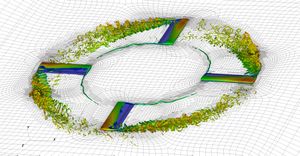UC5 - High-Fidelity Simulation of Rotating Parts
This use case aims at performing high-fidelity CFD simulations of a drone rotor with relatively complex geometry. The high-order solver Neko adopting the spectral element method will be used to investigate flow characteristics and noise generation.
Do you want to request support from EXCELLERAT staff or consulting on this Use Case?
*Registration is required to send inquiries.
Introduction
This is primarily an aerospace flow case, that can also be relevant for the automotive and energy sectors as well (e.g, wind turbine rotors). The main challenge is the accurate modelling of the moderately high Reynolds number flows. This is a difficult problem due to the large range of scales that have to be resolved. We will achieve sufficient resolution by applying adaptive mesh refinement, which will allow the control of the computational error and properly adjust the mesh during the simulation. We aim to perform high-fidelity modelling of a turbulent flow to investigate flow dynamics and noise generation. An important aspect is here in-situ data analysis, as saving the data to the disk will not be feasible. The simulations will be performed with the spectral element method solver Neko targeting EuroHPC GPU clusters.
The Challenge
Modelling the turbulent flows at high Reynolds numbers is a challenging and costly task, as it requires large meshes to resolve all the flow features. One of the possible solutions is reducing the range of the resolved flow scales by modelling the smallest ones with e.g., large eddy simulations. However, this introduces an additional modelling error and may provide inaccurate results for more complex flows. The other solution is the use of advanced mesh adaptation techniques that adjust the mesh to the flow structure and reduce the cost of obtaining the results needed. For the current use case, we are going to use an h-type adaptive mesh refinement framework implemented in the spectral element method solver Neko.
Aim
The current use case demonstrates the application of high-fidelity simulations to investigate the flow dynamics for high Reynolds number flows in relatively complex geometries. We focus on the flow around a drone rotor, studying wake characteristics and noise generation.
Development
Multiple aspects of numerical modelling can be tested and improved with this use case. As it consists of a relatively complex geometry, the generation of a high-quality high-order hex-based mesh is a challenge that will be addressed. Meshing flexibility is significantly increased by the use of adaptive mesh refinement and using the immersed boundary method.
Moreover, CU-5 is a complex flow with a large variety of flow features (e.g. tip and secondary vortices) that can be analysed in multiple ways. This allows the development of different methods, algorithms and implementation of in-situ data reduction, that can potentially combine Neko with additional software. The main interests here are the streaming algorithms for proper orthogonal decomposition (POD) and dynamic mode decomposition (DMD).
This use case with a sufficiently high Reynolds number can also become relatively large, allowing the testing of the parallel efficiency of the solver and the quality of the load balancing.
Benefits
This use case is meant to demonstrate a whole simulation workflow for a large problem size starting with mesh generation, then performing the simulation and ending in post-processing. Multiple simulation aspects are considered here including solution accuracy, reliability controlling computation error during the simulation and uncertainty quantification. The other key features are in-situ data analysis and the aeroacoustics.
The developed workflow can be easily adapted to the simulation of other devices like ship propellers or wind turbines.

